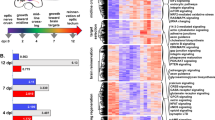Abstract
α1 tubulin gene expression is induced in the developing and regenerating CNS of vertebrates. Therefore, α1 tubulin gene expression may serve as a good probe for mechanisms underlying CNS development and regeneration. One approach to identify these mechanisms is to work backwards from the genome. This requires identification of α1 tubulin DNA sequences that mediate its developmental and regeneration-dependent expression pattern. Therefore, we generated transgenic zebrafish harboring a fragment of the α1 tubulin gene driving green fluorescent protein expression (GFP). In these fish, and similar to the endogenous gene, transgene expression was dramatically induced in the developing and regenerating nervous system. Although transgene expression generally declined during maturation of the nervous system, robust GFP expression was maintained in progenitor cells in the retinal periphery, lining brain ventricles and surrounding the central canal of the spinal cord. When these cells were cultured in vitro they divided and gave rise to new neurons. We also show that optic nerve crush in adult fish re-induced transgene expression in retinal ganglion cells. These studies identified a relatively small region of the α1 tubulin promoter that mediates its regulated expression pattern in developing and adult fish. This promoter will be extremely useful to investigators interested in targeting gene expression to the developing or regenerating nervous system. As adult transgenic fish maintain transgene expression in neural progenitors, these fish also provide a valuable resource of labeled adult neural progenitor cells that can be studied in vivo or in vitro. Finally, these fish should provide a unique in vivo system for investigating mechanisms mediating CNS development and regeneration.
Similar content being viewed by others
References
Barthel LK and Raymond PA (1990) Improved method for obtaining 3 micron cryosections for immunohistochemistry. J Histochem Cytochem 38: 1383–1388.
Bormann P, Zumsteg VM, Roth LW and Reinhard E (1998) Target contact regulates GAP-43 and alpha-tubulin mRNA levels in regenerating retinal ganglion cells. J Neurosci Res 52: 405–419.
Driever W, Solnica-Krezel L, Schier AF, Neuhauss SC, Malicki J and Stemple C (1996) A generic screen for mutations affecting embryogenesis in zebrafish. Development 123: 37–46.
Gloster A, El-Bizri H, Bamji SX, Rogers D and Miller FD (1999) Early induction of Tα1 α-tubulin transcription in neurons of the developing nervous system. J Comp Neurol 405: 45–60.
Gloster A, Wu W, Speelman A, Weiss S, Causing C, Posniak C, et al. (1994) The Tα1 α-tubulin promoter specifies gene expression as a function of neuronal growth and regeneration in transgenic mice. J Neurosci 14: 7319–7330.
Griffin KJP, Amacher SL, Kimmel CB & Kimelman D (1998) Molecular identification of spadetail: regulation of zebrafish trunk and tail mesoderm formation by T-box genes. Development 125: 3379–3388.
Haffter P, Granato M, Brand M, Mullins MC, Hammerschmidt M, Kane DA, et al. (1996) The identification of genes with unique and essential functions in the development of the zebrafish, Danio rerio. Development 123: 1–36.
Heidemann SR (1996) Cytoplasmic mechanisms of axonal and dendritic growth in neurons. Int Rev Cytol 165: 235–296.
Hieber V and Goldman D (1995) Trans-synaptic regulation of NMDA receptor RNAs during optic nerve regeneration. J Neurosci 15: 5286–5296.
Hieber V, Dai X, Foreman M and Goldman D (1998) Induction of α1-tubulin gene expression during development and regeneration of the fish central nervous system. J Neurobiol 37: 429–440.
Higashijima S, Hotta Y and Okamoto H (2000) Visualization of cranial motor neurons in live transgenic zebrafish expressing Green fluorescent protein under control of the islet-1 promoter/ enhancer. J Neurosci 20: 206–218.
Jowett T (1997) Tissue In Situ Hybridization: Methods in Animal Developement (EMBO Practical Course). Wiley, New York, NY.
Laferriere NB, MacRae TH and Brown DL (1997) Tubulin synthesis and assembly in differentiating neurons. Biochem. Cell Biol 75: 103–117.
Marcus RC, Delaney CL and Easter Jr. SS (1999) Neurogenesis in the visual system of embryonic and adult zebrafish (Danio rerio). Visual Neurosci 16: 417–424.
Meng A, Tang H, Ong BA, Farrell MJ and Lin S (1997) Promoter analysis in living zebrafish embryos identifies a cis-acting motif required for neuronal expression of GATA-2. Proc Natl Acad Sci USA 94: 6267–6272.
Miller FD, Naus CCG, Durand M, Bloom FE and Milner RJ (1987) Isotypes of α-tubulin are differentially regulated during neuronal maturation. J Cell Biol 105: 3065–3073.
Ross LS, Parrett T and Easter Jr. SS (1992) Axonogenesis and morphogenesis in the embryonic zebrafish brain. J Neurosci 12: 467–482.
Sullivan KF (1988) Structure and utilization of tubulin isotypes. Ann Rev Cell Biol 4: 687–716.
Schier AF, Neuhauss SCF, Harvey M, Malicki J, Solnica-Krezel L, Stainier DYR, et al. (1996) Mutations affecting development of the embryonic zebrafish brain. Development 123: 165–178.
Sullivan KF (1988) Structure and utilization of tubulin isotypes. Ann Rev Cell Biol 4: 687–716.
Westerfield M (1993) The Zebrafish Book. A guide for the laboratory use of zebrafish (Danio rerio). University of Oregon Press, Eugene, OR.
Zupanc GKH and Horschke I (1995) Proliferation zones in the brain of adult Gymnotiform fish: A quantitative study. J Comp Neurol 353: 213–233.
Author information
Authors and Affiliations
Rights and permissions
About this article
Cite this article
Goldman, D., Hankin, M., Li, Z. et al. Transgenic Zebrafish for Studying Nervous System Development and Regeneration. Transgenic Res 10, 21–33 (2001). https://doi.org/10.1023/A:1008998832552
Issue Date:
DOI: https://doi.org/10.1023/A:1008998832552




